Proposal
The online fashion market is currently dominated by fast fashion globally with a valuation of $136.19 billion for 2024. Fast fashion prioritizes speed and volume over quality and longevity, and most e-commerce platforms are saturated with a constant stream of new but poor-quality products that quickly become obsolete, thus contributing textile waste to local landfills. In the Philippines, garment imports have surged while more and more Filipinos are throwing away items of clothing after wearing it just once.
However, there seems to be an emerging interest in the secondhand apparel market and circular fashion alternatives, globally and within the Southeast Asian region. In 2021, Filipino online shoppers ranked 4th globally among 25 countries in purchasing eco-friendly and sustainable products through e-commerce platforms, with 60% of respondents reporting at least one online purchase of a sustainable or eco-friendly goods, hence displaying relatively high environmental awareness and conscious consumption.
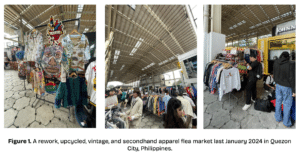
According to a Statista report studying the demographic distribution of e-commerce users in the Philippines as of June 2023, results showed that the highest proportion of Filipino online shoppers or 35.6% are in the 25-34 age range while 29.3% are in the 18-24 age range. When combined, these younger generations make up 64.9% of all shoppers.
Yet when Filipinos are asked why they haven’t made the switch to a greener wardrobe, Rakutan Insight cited two main pain points which lead to a barrier in adopting sustainable practices. First, 42% reported a lack of sufficient information to make sustainable choices. Second, 41% of respondents stated that adopting sustainability practices were too expensive for them.
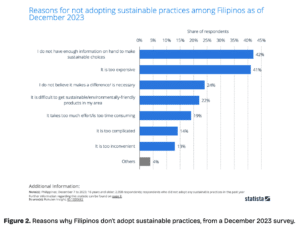
Figure 2 implies that the Philippines is lacking the infrastructure to render sustainable fashion as an accessible, available, and affordable choice for most Filipinos. The affordability of a clothing item is tied to its perceived value, and Figure 3 implies that if an item has high quality, durability, and comfort, then it is higher in value. Therefore, an item is more affordable when its price meets its perceived value.
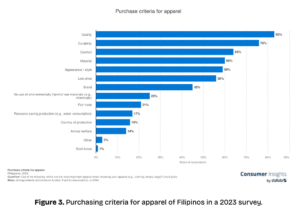
Depending on the material of the fabric and storage conditions, the quality, durability, and comfort of clothes depreciate over time, making it a liability to its owner due to the lack of monetary return-of-investment (ROI). E-commerce is not optimized for vetting the quality of apparel, and lack of end-of-life management accumulates as clutter which decreases the quality of life of the user. Ultimately, infrequent use results in the total non-usage and disinterest in the clothing item.
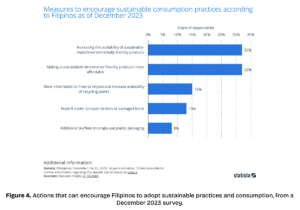
Our solution is simple. Patch wants to extend the lifespan of a clothing item’s perceived value. We want to leverage the market’s interest in sustainable consumption and offer circularity as a feasible alternative. The need for an intervention is urgent. Fast fashion’s rapid turnover and waste production are accelerating environmental damage over time. By providing a platform where users can buy and sell their pre-loved, thrifted, reworked, and vintage clothes, we can help the average Filipino subtly shift to circularity as seamlessly as possible.
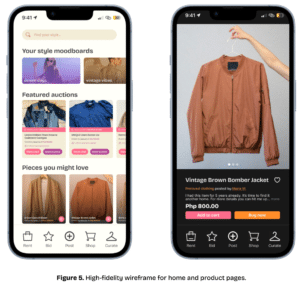
We streamline transactions between buyers and sellers by providing secure payment processing, efficient order management, and reliable communication tools. Patch generates revenue through various monetization strategies, such as transaction fees, listing fees and advertising.
The primary features of Patch are as follows which functionalities are designed to enhance the sustainable shopping experience:
- Bid and Rent: Patch offers a variety of in-app transactions, allowing users to seamlessly engage in sustainable behavior with confidence and ease.
- Online Escrow Service: To ensure secure transactions, Patch implements an online escrow system that protects both buyers and sellers from fraud, fostering reliability within the platform.
- Outfit Curation Challenges: Patch and our community can organize outfit curation challenges, encouraging users to express their unique style while championing the products of sustainable brands, sellers and small businesses. These challenges foster community engagement and creativity.
- Augmented Reality Try-on: Users can explore virtual closets and try on products listed in Patch using augmented reality technology, providing an immersive and interactive shopping experience that transcends physical limitations.
Patch’s focus on Sustainable Development Goals (SDG) 9 and 12 underscores its commitment to drive a positive change in the fashion industry. By aligning with SDG 9, Patch aims to foster innovation in sustainable fashion technology and infrastructure. This involves leveraging technology to streamline circular fashion behavior and enhance supply chain transparency, to build an online retail platform committed to upholding sustainability. Meanwhile, under SDG 12, Patch can encourage responsible consumption and circular fashion principles by enabling its consumers to make informed purchasing decisions without sacrificing style or convenience. Moreover, by facilitating the resale, rental and upcycling of clothing items, Patch promotes circularity within the fashion industry hence extending the lifespan of garments and reducing waste. Given these efforts, Patch not only addresses the harmful environmental impact of wasteful fashion consumption, but it also promotes social responsibility and ethical practices throughout the supply chain.
By 2030, we hope to see Patch as one of the leading destinations for circular fashion worldwide, with a thriving community of users, sellers, and partners. We aim to have a significant impact on reducing waste, carbon emissions, and environmental degradation associated with the fashion industry, contributing to a more sustainable and ethical future for fashion.

